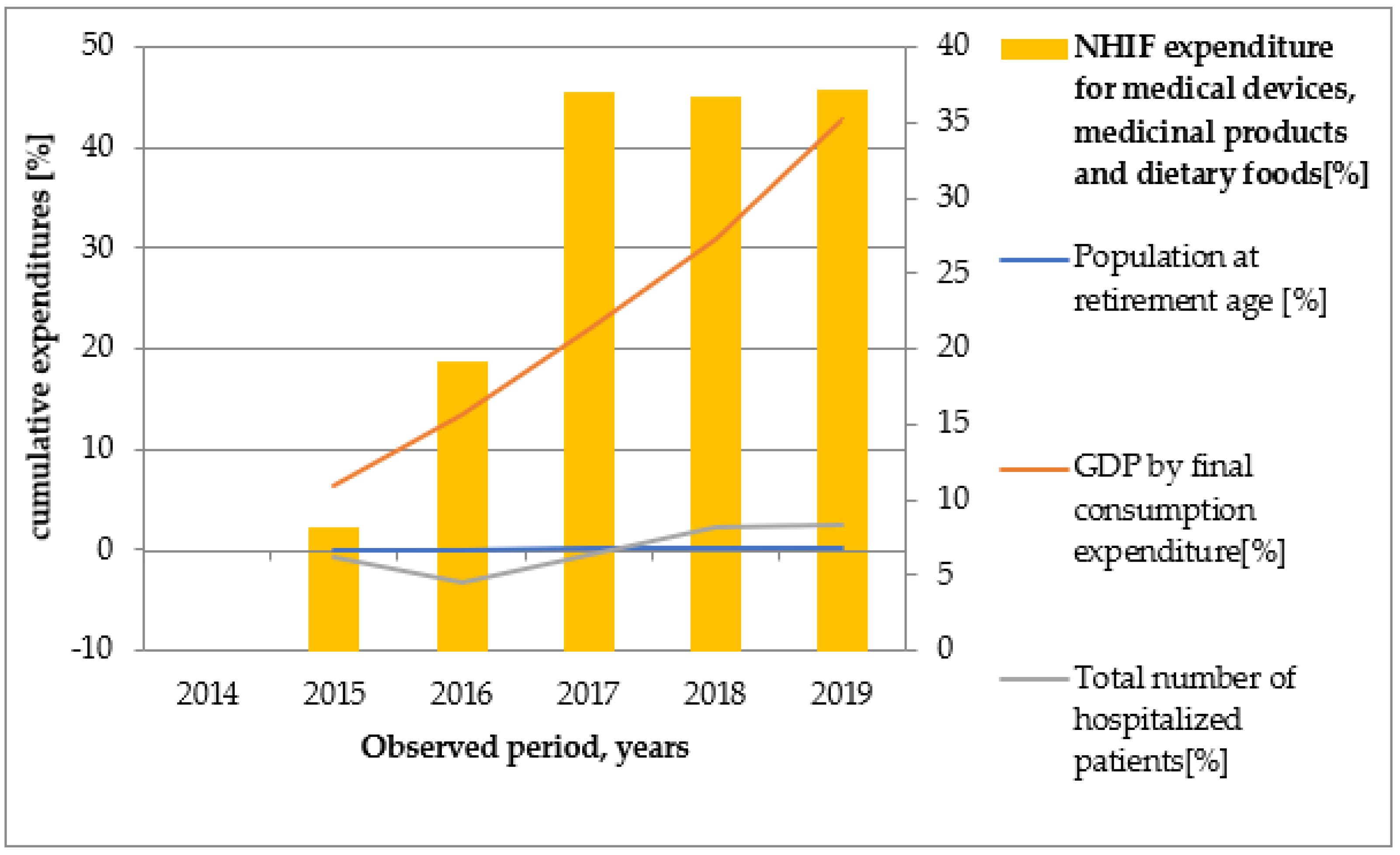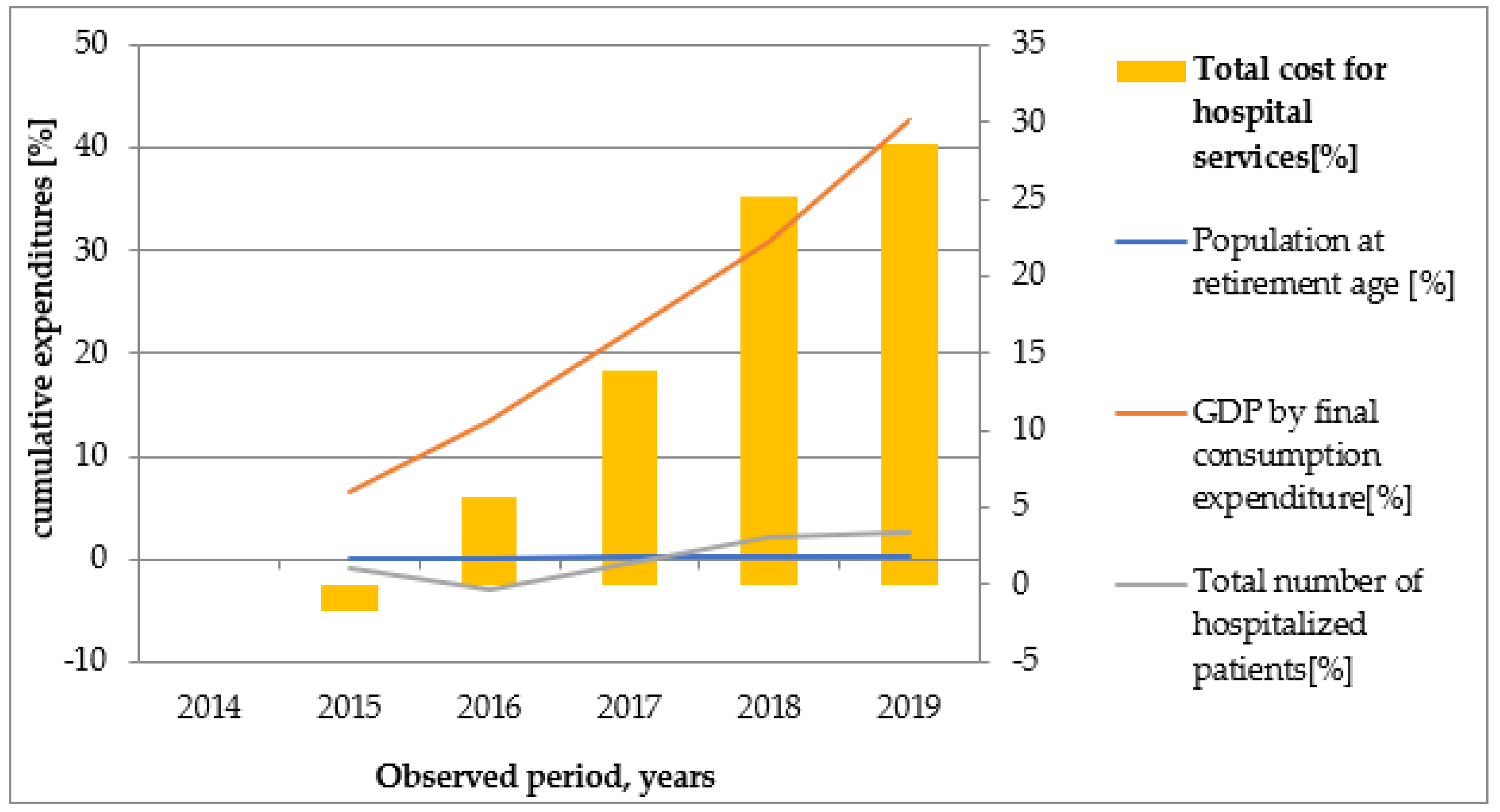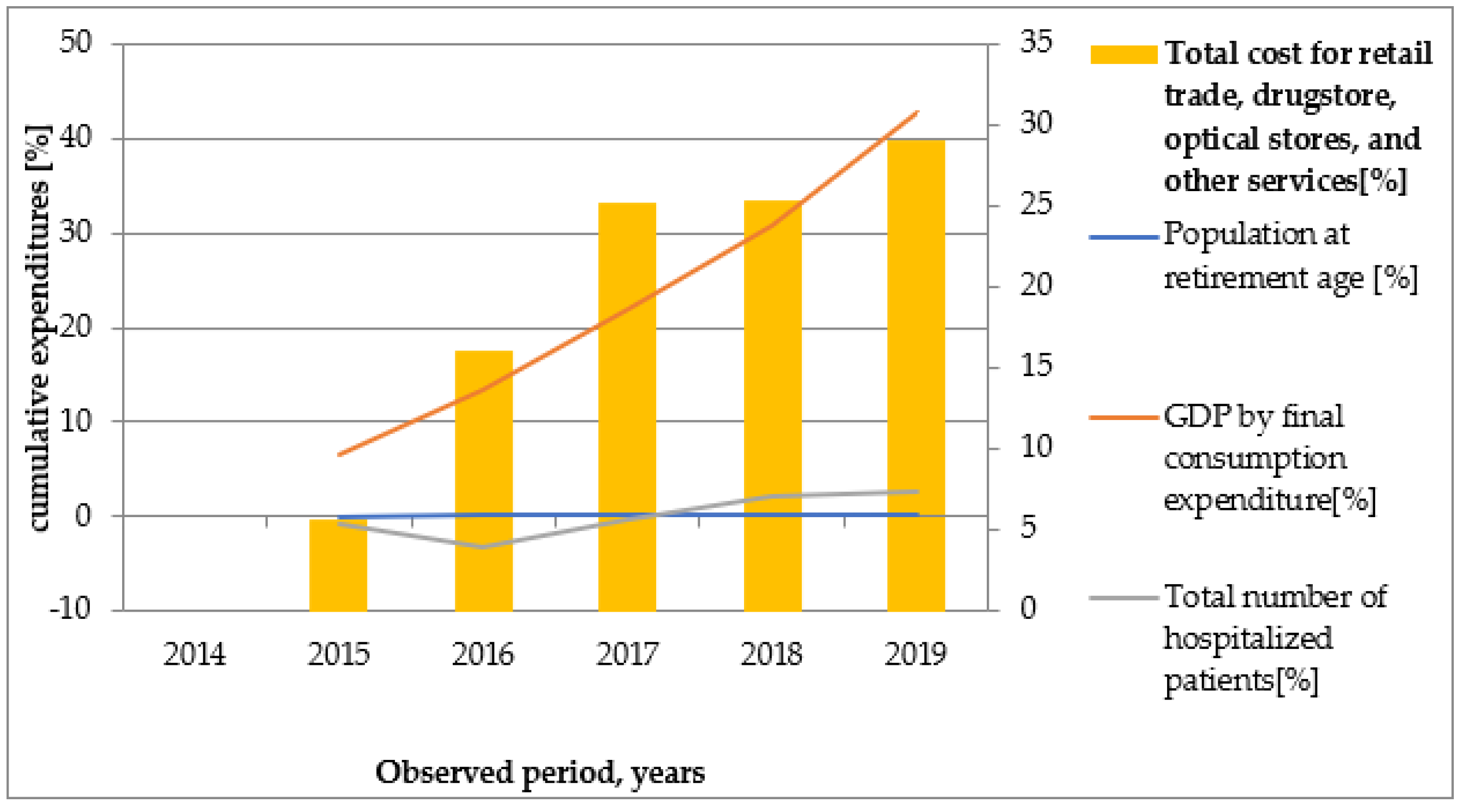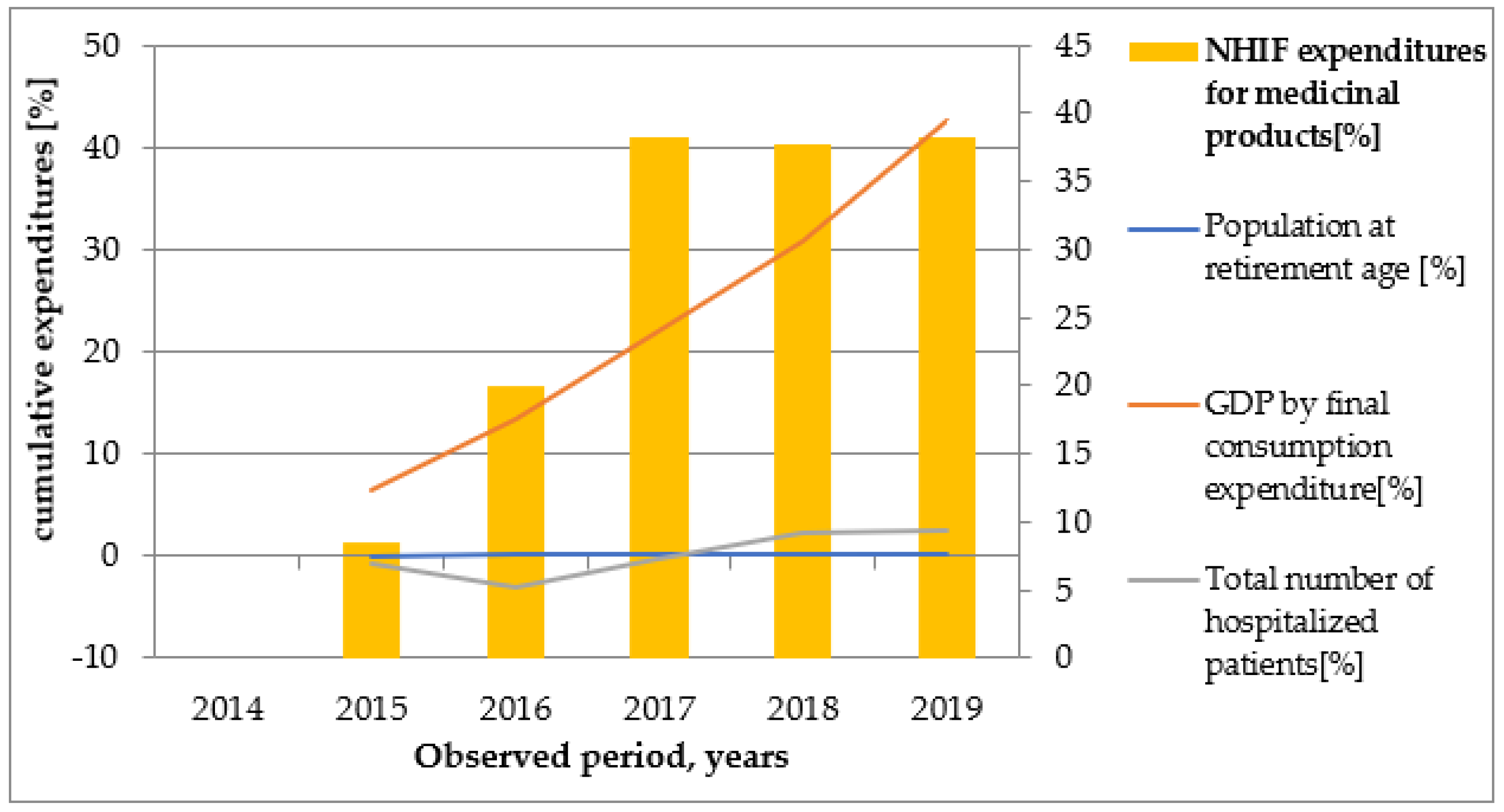Analysis of Healthcare Expenditures in Bulgaria
Abstract
1. Introduction
2. Materials and Methods
| Group of Indicators | Observed Indicators | Sources |
|---|---|---|
| Public healthcare expenditure |
| National Statistical Institute: system of health accounts [19]. |
| NHIF annual reports published during 2014–2019 [20].The reports for the period 2014–2019 were observed. | |
| Healthcare system performance indicators |
| National Statistical Institute: healthcare [21].The reports for the period 2014–2019 were observed. |
| National Center of Public Health and Analysis: healthcare short statistical guide [22].The reports for the period 2014–2019 were observed. | |
| National Statistical Institute: deaths and mortality by causes [23]. | |
| Demographic characteristics of population |
| National Statistical Institute: population—demography, migration, and forecasts [24].The reports for the period 2014–2019 were observed. |
| Economic indicators |
| National Statistical Institute: macroeconomic statistics, GDP. |
| The World Bank Data on inflation customer prices [25]. |
3. Results
3.1. Overview of Health Expenditures in Bulgaria
3.2. Healthcare System Performance Indicators
3.3. Other Factors Affecting Healthcare Expenditure
3.4. Demographic Indicators
3.5. Economic Factors
3.6. The Relationship between Healthcare Expenditure and Other Indicators under Consideration
4. Discussion
5. Conclusions
Author Contributions
Funding
Institutional Review Board Statement
Informed Consent Statement
Data Availability Statement
Conflicts of Interest
References
- Organization for Economic Co-operation and Development (OECD). European Union. Health Expenditure in Relation to GDP. Health at A Glance: Europe; OECD Publishing/Brussels: Paris, France; European Union: Maastricht, The Netherlands, 2018. [Google Scholar]
- Eurostat. Healthcare Expenditure Statistics. Available online: https://ec.europa.eu/eurostat/statistics-explained/index.php?title=Healthcare_expenditure_statistics (accessed on 20 October 2021).
- Keehan, S.P.; Cuckler, G.A.; Poisal, J.A.; Sisko, A.M.; Smith, S.D.; Madison, A.J.; Rennie, K.E.; Fiore, J.A.; Hardesty, J.C. National Health Expenditure Projections, 2019–2028: Expected Rebound in Prices Drives Rising Spending Growth. Heal. Aff. 2020, 39, 704–714. [Google Scholar] [CrossRef] [PubMed]
- Goryakin, Y.; Thiébaut, S.P.; Cortaredona, S.; Lerouge, M.A.; Cecchini, M.; Feigl, A.B.; Ventelou, B. Assessing the future medical cost burden for the European health systems under alternative exposure-to-risks scenarios. PLoS ONE 2020, 15, e0238565. [Google Scholar] [CrossRef] [PubMed]
- Raghupathi, V.; Raghupathi, W. Healthcare Expenditure and Economic Performance: Insights from the United States Data. Front. Public Health. 2020, 8, 156. [Google Scholar] [CrossRef] [PubMed]
- Yang, B.; Usman, M.; Jahanger, A. Do industrialization, economic growth and globalization processes influence the ecological footprint and healthcare expenditures? Fresh insights based on the STIRPAT model for countries with the highest healthcare expenditures. Sustain. Prod. Consum. 2021, 28, 893–910. [Google Scholar] [CrossRef]
- Ali, A.A.; Sayed, M.N. Determinants of Healthcare Expenditures in GCC Countries: A Panel Data Analysis. J. Asian Financ. Econ. Bus. 2020, 7, 705–714. [Google Scholar] [CrossRef]
- Ben-Aharon, O.; Shavit, O.; Magnezi, R. Does drug price-regulation affect healthcare expenditures? Eur. J. Health Econ. 2017, 18, 859–867. [Google Scholar] [CrossRef]
- Braendle, T.; Colombier, C. Budgetary targets as cost-containment measure in the Swiss healthcare system? Lessons from abroad. Health Policy 2020, 124, 605–614. [Google Scholar] [CrossRef]
- World Health Organization (WHO). The Financial Crisis and Global Health: Report of A High-Level Consultation; World Health Organization: Geneva, Switzerland, 2009. [Google Scholar]
- Kooli, C. COVID-19: Challenges and opportunities. Avicenna Editor. 2021, 1, 5. [Google Scholar] [CrossRef]
- Pricewater House Coopers UK. Healthcare Outcomes and Expenditure in Central and Eastern Europe—A Review. June 2021. Available online: https://www.efpia.eu/media/602945/pwc-strategy-report-increasing-healthcare-investment-in-cee-countries.pdf (accessed on 15 December 2021).
- Jakovljevic, M.; Fernandes, P.O.; Teixeira, J.P.; Rancic, N.; Timofeyev, Y.; Reshetnikov, V. Underlying Differences in Health Spending Within the World Health Organisation Europe Region—Comparing EU15, EU Post-2004, CIS, EU Candidate, and CARINFONET Countries. Int. J. Environ. Res. Public Health 2019, 16, 3043. [Google Scholar] [CrossRef]
- Kooli, C. COVID-19: Public health issues and ethical dilemmas. Ethics Med. Public Health 2021, 17, 100635. [Google Scholar] [CrossRef]
- Dranove, D.; Garthwaite, C.; Ody, C. Health Spending Slowdown Is Mostly Due to Economic Factors, Not Structural Change in The Health Care Sector. Health Affairs. 2014, 33, 1399–1406. [Google Scholar] [CrossRef] [PubMed][Green Version]
- Thavorn, K.; Maxwell, C.J.; Gruneir, A.; E Bronskill, S.; Bai, Y.; Pefoyo, A.J.K.; Petrosyan, Y.; Wodchis, W.P. Effect of socio-demographic factors on the association between multimorbidity and healthcare costs: A population-based, retrospective cohort study. BMJ Open 2017, 7, e017264. [Google Scholar] [CrossRef] [PubMed]
- von Wyl, V. Proximity to death and health care expenditure increase revisited: A 15-year panel analysis of elderly persons. Health Econ. Rev. 2019, 9. [Google Scholar] [CrossRef] [PubMed]
- Nedzinskienė, L.; Jurevičienė, E.; Visockienė, Ž.; Ulytė, A.; Puronaitė, R.; Kasiulevičius, V.; Kazėnaitė, E.; Burneikaitė, G.; Navickas, R. Structure and Distribution of Health Care Costs across Age Groups of Patients with Multimorbidity in Lithuania. Int. J. Environ. Res. Public Health 2021, 18, 2767. [Google Scholar] [CrossRef] [PubMed]
- National Statistical Institute (NSI). System of Health Accounts (SHA 2011). Available online: https://www.nsi.bg/bg/content/14521 (accessed on 15 May 2021).
- Annual Reports about National Health Insurance Fund (NHIF) Activity. Available online: https://www.nhif.bg/page/2035 (accessed on 17 May 2021).
- National Statistical Institute. Health Care. Statistical Yearbook. Available online: https://www.nsi.bg/bg/content/3280/%D0%B7%D0%B4%D1%80%D0%B0%D0%B2%D0%B5%D0%BE%D0%BF%D0%B0%D0%B7%D0%B2%D0%B0%D0%BD%D0%B5 (accessed on 15 May 2021).
- National Centre of Public Health and Analysis HEALTHCARE Short Statistical Guide. Available online: https://ncpha.government.bg/index/124-spravochnik-zdraveopazvane.html (accessed on 20 May 2021).
- National Statistical Institute. Deaths and Mortality by Causes. Available online: https://www.nsi.bg/bg/content/3348/ (accessed on 15 May 2021).
- National Statistical Institute. Population—Demography, Migration, and Forecasts. Available online: https://www.nsi.bg/bg/content/2920 (accessed on 15 May 2021).
- The World Bank Data. Inflation, Consumer Prices (annual %)—Bulgaria. Available online: https://data.worldbank.org/indicator/FP.CPI.TOTL. ZG?locations=BG (accessed on 10 August 2021).
- Przywara, B. Projecting future health care expenditure at European level: Drivers, methodology and main results. Eur. Econ. Econ. Pap. 2010, 417. [Google Scholar] [CrossRef]
- AlAhmad, Y.M.; Haggeer, D.M.; Alsayed, A.Y.; Haik, M.Y.; AbuAfifeh, L.M.; Aljaber, M.H.; Mohamed, A.A.; Balideh, A.; Almutawa, N.; Mahmoud, M.H. The Effect of Telemedicine on Patients’ Compliance in Family Medicine Follow-ups in Qatar. Avicenna 2022, 1, 3. [Google Scholar] [CrossRef]
- Guralnik, J.M.; LaCroix, A.Z.; Branch, L.G.; Kasl, S.V.; Wallace, R.B. Morbidity, and disability in older persons in the years prior to death. Am. J. Public Health 1991, 81, 443–447. [Google Scholar] [CrossRef] [PubMed][Green Version]
- Wouterse, B.; Huisman, M.; Meijboom, B.R.; Deeg, D.J.; Polder, J.J. The effect of trends in health and longevity on health services use by older adults. BMC Health Serv. Res. 2015, 24, 574. [Google Scholar] [CrossRef] [PubMed]
- Fisher, K.A.; Griffith, L.E.; Gruneir, A.; Upshur, R.; Perez, R.; Favotto, L.; Nguyen, F.; Markle-Reid, M.; Ploeg, J. Effect of socio-demographic and health factors on the association between multimorbidity and acute care service use: Population-based survey linked to health administrative data. BMC Health Serv. Res. 2021, 21. [Google Scholar] [CrossRef]
- Dieleman, J.L.; Squires, E.; Bui, A.L.; Campbell, M.; Chapin, A.; Hamavid, H.; Horst, C.; Li, Z.; Matyasz, T.; Reynolds, A.; et al. Factors Associated with Increases in US Health Care Spending, 1996–2013. JAMA 2017, 318, 1668–1678. [Google Scholar] [CrossRef]
- Bulgaria Country Review. National Center of Public Health and Analyses, the Republic of Bulgaria. Health Program 2008–2013 Funding by European Union. Available online: http://www.chrodis.eu/wp-content/uploads/2015/02/Bulgaria-CHRODIS-final-draft.pdf (accessed on 8 August 2021).
- World Health Organization (WHO). Pricing of Cancer Medicines and Its Impacts. World Health Organization: Geneva, 2018. Available online: https://apps.who.int/iris/bitstream/handle/10665/277190/9789241515115-eng.pdf?sequence=1&isAllowed=y (accessed on 10 August 2021).
- Bolnick, H.; Bui, A.; Bulchis, A.; Chen, C.; Chapin, A.; Lomsadze, L.; Mokdad, A.; Millard, F.; Dieleman, J. Healthcare spending attributable to modifiable risk factors in the USA: An economic attribution analysis. Lancet Public Health 2020, 5, e525–e535. [Google Scholar] [CrossRef]
- Radu, C.P.; Pana, B.C.; Pele, D.T.; Costea, R.V. Evolution of Public Health Expenditure Financed by the Romanian Social Health Insurance Scheme From 1999 to 2019. Front. Public Health 2021, 9, 795869. [Google Scholar] [CrossRef] [PubMed]
- Okunad, A.A.; Murthy, V.N. Technology as a ‘major driver’ of health care costs: A cointegration analysis of the Newhouse conjecture. J. Health Econ. 2002, 21, 147–159. [Google Scholar] [CrossRef]
- Demographic Changes and Aggregate Health-Care Expenditure in Europe. European Network of Economic Policy Research Institutes 2007. Available online: https://www.ceps.eu/download/publication/?id=5774&pdf=1575.pdf (accessed on 3 August 2021).
- Stepovic, M.; Rancic, N.; Vekic, B.; Dragojevic-Simic, V.; Vekic, S.; Ratkovic, N.; Jakovljevic, M. Gross Domestic Product and Health Expenditure Growth in Balkan and East European Countries-Three-Decade Horizon. Front. Public Health 2020, 8, 492. [Google Scholar] [CrossRef] [PubMed]
- Mackenbach, J.P.; Kunst, A.E.; Cavelaars, A.E.; Groenhof, F.; Geurts, J.J. Socioeconomic inequalities in morbidity and mortality in western Europe. The EU Working Group on Socioeconomic Inequalities in Health. Lancet 1997, 349, 1655–1659. [Google Scholar] [CrossRef]
- Fogel, R. Economic Growth, Population Theory, and Physiology: The Bearing of Long-Term Processes on the Making of Economic Policy; National Bureau of Economic Research Inc American Economic Review. Am. Econ. Assoc. 1994, 84, 369–395. Available online: https://EconPapers.repec.org/RePEc:nbr:nberwo:4638 (accessed on 3 August 2021).
- Tkachova, O.; Iakovlieva, L.; Mitkova, Z.; Manova, M.; Savova, A.; Petrova, G. An affordability of statins therapy—comparative analysis between Ukraine and Bulgaria. BMC Health Serv. Res. 2019, 19, 902. [Google Scholar] [CrossRef]
- Porcelli, F. Electoral Accountability and Local Government Efficiency: Quasi-Experimental Evidence from the Italian Health Care Sector Reforms. Econ. Gov. 2014, 15, 221–251. [Google Scholar] [CrossRef]






| 2014 | 2015 | 2016 | 2017 | 2018 | 2019 | Mean ± SD | |
|---|---|---|---|---|---|---|---|
| Total cost for outpatient services | 1017 | 1080 | 1105 | 1207 | 1228 | 1281 | 1153 ± 101 |
| Total cost for hospital services | 2484 | 2441 | 2624 | 2831 | 3111 | 3196 | 2781 ± 320 |
| Total cost for retail trade, drugstores, optical stores, and other services | 2360 | 2494 | 2740 | 2955 | 2959 | 3047 | 2759 ± 279 |
| NHIF expenditures for medicinal products | 577 | 626 | 693 | 798 | 795 | 798 | 714.5 ± 97 |
| NHIF expenditure for medical devices, medicinal products, and dietary foods | 600 | 649 | 715 | 822 | 820 | 823 | 738.2 ± 98 |
| Differences in Percentage Considering | 2014/2015 | 2015/2016 | 2016/2017 | 2017/2018 | 2018/2019 | Mean ± SD |
|---|---|---|---|---|---|---|
| Total costs for outpatient services | 6.213 | 2.397 | 9.107 | 1.775 | 4.328 | 4.76 ± 2.98 |
| Total cost for retail trade, drugstores, optical stores, and other services | 5.681 | 9.875 | 7.824 | 0.128 | 2.979 | 5.29 ± 3.85 |
| Total cost for hospital services | −1.747 | 7.518 | 7.874 | 9.875 | 2.753 | 5.25 ± 4.71 |
| NHIF expenditures for medicinal products | 8.430 | 10.668 | 15.277 | −0.392 | 0.307 | 6.85 ± 6.77 |
| Year | 2014 | 2015 | 2016 | 2017 | 2018 | 2019 |
|---|---|---|---|---|---|---|
| Total number of hospitalized patients | 2,238,478 | 2,217,476 | 2,169,645 | 2,220,161 | 2,288,887 | 2,292,167 |
| Number of hospitalized patients due to diseases of the circulatory system [22] | 321,074 | 317,486 | 324,178 | 328,928 | 325,543 | 327,676 |
| Number of hospitalized patients due to respiratory system diseases | 239,978 | 223,661 | 212,770 | 218,498 | 222,124 | 229,217 |
| Number of hospitalized patients due to cancer diseases | 159,613 | 156,995 | 165,502 | 167,282 | 182,252 | 172,549 |
| Mortality from the diseases of the circulatory system | 71,760 | 72,028 | 70,459 | 71,997 | 70,546 | 69,632 |
| Mortality from the oncology diseases | 18,113 | 18,020 | 17,294 | 17,429 | 17,462 | 18,298 |
| Mortality in infants including neonates (0–1 years of age) | 517 | 434 | 423 | 408 | 358 | 342 |
| Parameter | 2014 | 2015 | 2016 | 2017 | 2018 | 2019 |
|---|---|---|---|---|---|---|
| Population size | 7,202,198 | 7,153,784 | 7,101,859 | 7,050,034 | 7,000,039 | 6,951,482 |
| Average life expectancy | 74.5 | 74.7 | 74.9 | 74.8 | 75.0 | 74.9 * |
| Population over working age (retirement age) | 1,734,089 | 1,740,749 | 1,734,718 | 1,735,538 | 1,732,018 | 1,728,730 |
| Ratio of the population aged 65 and over to the population aged 15 to 64 | 30.2 | 31.1 | 31.8 | 32.5 | 33.2 | 33.8 |
| Year | 2014 | 2015 | 2016 | 2017 | 2018 | 2019 | Mean ± SD |
|---|---|---|---|---|---|---|---|
| GDP by final consumption expenditure (million BGN) | 83,885 | 89,362 | 95,131 | 102,345 | 109,743 | 119,772 | 100,039.7 ± 13,326.03 |
| GDP per capita | 12,800 | 13,186 | 13,901 | 14,687 | 15,534 | 16,508 | 14,436 ± 1420.3 |
| Average monetary expenditures per person | 4443 | 4605 | 4699 | 5161 | 5710 | 6158 | 5129.333 ± 682.22 |
| Average monetary expenditures for healthcare per person | 235 | 248 | 263 | 280 | 313 | 386 | 287.5 ± 55.36 |
| Gross monetary income per person | 4591 | 4741 | 4945 | 5288 | 5691 | 6279 | 5255.83 ± 638.90 |
| Average yearly inflation in healthcare sector (%) | −3.4 | −1.6 | −0.2 | 0.2 | 0.2 | 1.3 | −0.58 ± 1.67 |
| Inflation of medicinal product prices (%) | −1.6 | −2.3 | −0.5 | 0.0 | 0.1 | 1.3 | −0.5 ± 1.29 |
| Inflation of medicinal devices and equipment prices (%) | 1.3 | 0.8 | 0.8 | 2.1 | 1.5 | 1.1 | 1.27 ± 0.49 |
Publisher’s Note: MDPI stays neutral with regard to jurisdictional claims in published maps and institutional affiliations. |
© 2022 by the authors. Licensee MDPI, Basel, Switzerland. This article is an open access article distributed under the terms and conditions of the Creative Commons Attribution (CC BY) license (https://creativecommons.org/licenses/by/4.0/).
Share and Cite
Mitkova, Z.; Doneva, M.; Gerasimov, N.; Tachkov, K.; Dimitrova, M.; Kamusheva, M.; Petrova, G. Analysis of Healthcare Expenditures in Bulgaria. Healthcare 2022, 10, 274. https://doi.org/10.3390/healthcare10020274
Mitkova Z, Doneva M, Gerasimov N, Tachkov K, Dimitrova M, Kamusheva M, Petrova G. Analysis of Healthcare Expenditures in Bulgaria. Healthcare. 2022; 10(2):274. https://doi.org/10.3390/healthcare10020274
Chicago/Turabian StyleMitkova, Zornitsa, Miglena Doneva, Nikolay Gerasimov, Konstantin Tachkov, Maria Dimitrova, Maria Kamusheva, and Guenka Petrova. 2022. "Analysis of Healthcare Expenditures in Bulgaria" Healthcare 10, no. 2: 274. https://doi.org/10.3390/healthcare10020274
APA StyleMitkova, Z., Doneva, M., Gerasimov, N., Tachkov, K., Dimitrova, M., Kamusheva, M., & Petrova, G. (2022). Analysis of Healthcare Expenditures in Bulgaria. Healthcare, 10(2), 274. https://doi.org/10.3390/healthcare10020274






